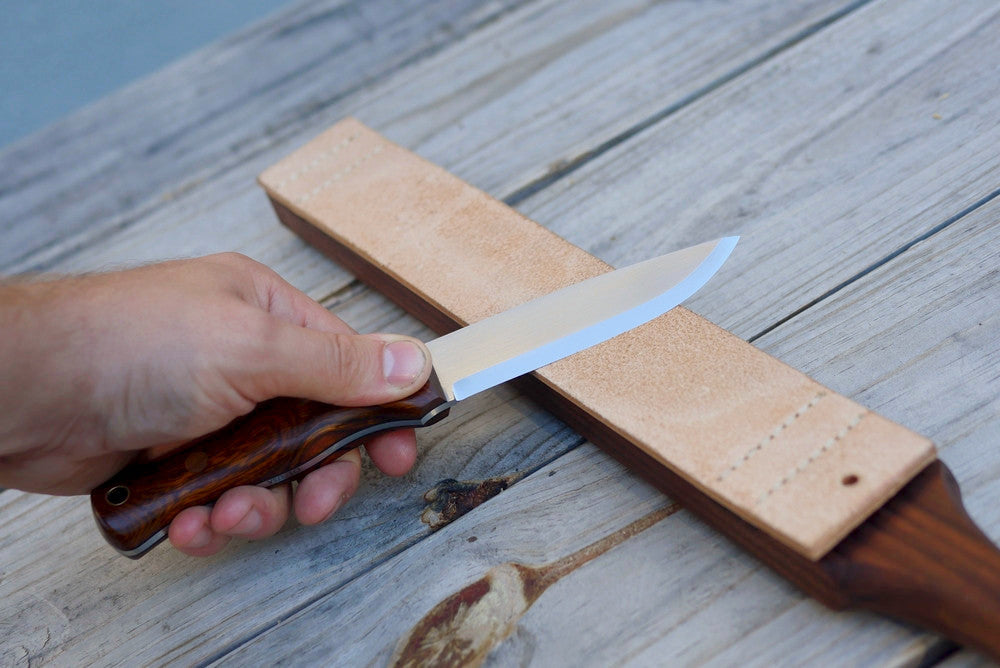Note: any image is a link directly to our leather strop product page
A leather strop is a piece of leather which is used for de-burring, polishing, or sharpening a blade's edge. For rigidity, strops are often fixed on to a wooden base. The sharpening capabilities really shine when the leather is used in conjunction with compound or another abrasive paste, such as a diamond slurry.
We wanted our strops to fix issues which we didn't like with a standard double-sided strop. So we designed them a bit different.

Many strops have a wooden base with leather pad glued to one side. Some are double, or even four-sided, but they all have one thing in common - the leather pad is permanently glued to the board. This creates a few issues for us:
-1- If you use a variety of abrasive compounds on your strops (3+), then you're going to need multiple strops-2- If you are experimenting with compounds and load the strop with a crappy compound, it is quite difficult to get it out of the leather (if not impossible) without ruining the leather. This is a problem when the leather is permanently fixed to the base.
-3- If you set the strop on a surface when using it, the underside will annoyingly dirty the surface, and, even worse, the underside pad may absorb foreign matter, effecting the strop's efficiency
So we thought, why not have removable leather pads?
Replacement pads would be cheaper than owning multiple strops entirely, and would allow for a huge range of abrasives to be used. If you charge one with some bad compound, it's only a $10 pad lost instead of the entire strop.
After experimenting and ruling out a clamping system, we ended up deciding that velcro was the most efficient. We're using the same linen thread that we use for our sheaths, as you can strop over the top of the linen with no problems. In fact, many strops are made entirely of linen.
By default the stropping area between the stitching is directly on top of the flat, sturdy walnut. The strips for the velcro are towards the ends, and are countersunk to ensure the leather lays flat.
We went with walnut because it's strong, and it won't discolor as noticeably from contact with various compounds as a lighter wood might. The craftsmanship might look familiar, each base is handmade by Ed, the same guy who does our bucksaws.
Seeing how the underside was freed up, we added non-slip rubber feet. The feet add knuckle clearance when stropping. For the same reason, the walnut we're using is a hefty 3/4 inches thick. The contoured 5 inch handle keeps your hand a safe distance from the blade when stropping, and has a 5/16 inch hole for hanging it up or attaching a lanyard.
In our experience, the ideal leather for stropping is a dense vegetable tanned cowhide. The rougher flesh side works far more quickly than the smooth skin side, and it seems to take compound better. However, some people do prefer the smooth skin side for a final touch. The smooth side almost eliminates any micro-convexing of the cutting edge, which certain individuals like (such as those who sharpen straight-razors).
Leather Pad Overall Size: 2 x 12.75 inches
Distance between stitching: 9.5 inches
We may come out with a couple variants down the road, such as an XL size and a small backpack size. We'd love to hear your input in the comments below this post. Thanks for checking these out!
Current Price: $69.95 with one pad included
Link to our Walnut Leather Strop product page







2 comments
Love this idea it’s fantastic
I think this design is a great idea. I would like to see this in a small camping version. With the pads reversible and having the rough side on both sides. So to have a fine and rough grit. Maybe 1.5 v 6 inch? Overall looks great !